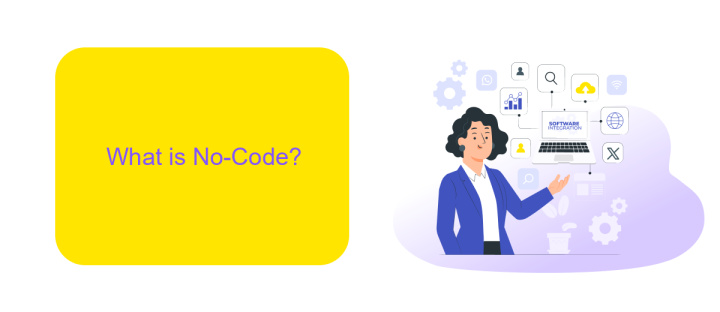Is No-Code the Future
In an era where digital transformation is paramount, the rise of no-code platforms is revolutionizing how applications are developed. By enabling users to create complex software without traditional coding skills, no-code tools are democratizing technology and empowering a broader audience to innovate. This article explores whether no-code is not just a trend, but the future of software development.
Introduction
The rise of no-code platforms has revolutionized the way individuals and businesses approach software development. By eliminating the need for traditional coding skills, these platforms empower a broader audience to create, customize, and deploy applications quickly and efficiently. This democratization of technology opens up new opportunities for innovation and productivity.
- Streamlined development processes
- Reduced dependency on specialized developers
- Faster time-to-market for applications
- Cost-effective solutions
One notable example of a no-code platform is ApiX-Drive, which facilitates seamless integrations between various applications and services. By offering a user-friendly interface, ApiX-Drive enables users to automate workflows and synchronize data without writing a single line of code. Such tools are not only transforming the tech landscape but also proving that no-code solutions could indeed be the future of software development.
What is No-Code?

No-Code is a revolutionary approach to software development that allows individuals to create applications and automate workflows without writing any code. This paradigm shift democratizes the development process, enabling not only developers but also non-technical users to build functional software solutions. With intuitive drag-and-drop interfaces and pre-built templates, No-Code platforms significantly reduce the time and cost associated with traditional coding methods.
One of the key advantages of No-Code platforms is their ability to integrate various services seamlessly. For instance, ApiX-Drive is a powerful tool that facilitates easy integration of different applications and services without the need for complex coding. Users can set up automated workflows, synchronize data across platforms, and streamline business processes with just a few clicks. This makes No-Code an attractive option for businesses looking to enhance efficiency and agility in their operations.
Benefits of No-Code

No-code platforms are revolutionizing the way businesses and individuals approach software development by making it more accessible and efficient.
- Speed and Efficiency: No-code tools allow for rapid prototyping and deployment, significantly reducing the time needed to bring an idea to life.
- Cost-Effective: By eliminating the need for extensive coding expertise, no-code solutions reduce development costs, making it easier for startups and small businesses to innovate.
- Empowerment: These platforms empower non-technical users to create and manage applications, democratizing the development process.
- Integration Capabilities: Services like ApiX-Drive facilitate seamless integration of various applications, enhancing the functionality of no-code solutions without requiring complex coding.
- Flexibility: No-code platforms offer a high degree of flexibility, allowing users to easily modify and scale their applications as needed.
Overall, no-code platforms are transforming the landscape of software development by making it more inclusive, cost-effective, and adaptable. With tools like ApiX-Drive, integrating and automating workflows has never been easier, further enhancing the appeal of no-code solutions.
Challenges of No-Code

No-code platforms have revolutionized the way businesses approach software development, but they come with their own set of challenges. One significant issue is the limitation in customization. While these platforms offer a variety of templates and pre-built components, they often fall short when unique, complex functionalities are required.
Another challenge is scalability. No-code solutions may work well for small projects or startups but can become inefficient and cumbersome as the business grows. This can lead to performance bottlenecks and increased technical debt, requiring more advanced solutions down the line.
- Customization limitations
- Scalability issues
- Integration complexities
- Security concerns
Integration complexities also pose a challenge. While services like ApiX-Drive help streamline integrations between various platforms, the process can still be intricate and time-consuming. Lastly, security is a crucial concern, as no-code platforms may not offer the same level of data protection and compliance as custom-coded solutions. Addressing these challenges is essential for businesses to fully leverage the benefits of no-code development.
- Automate the work of an online store or landing
- Empower through integration
- Don't spend money on programmers and integrators
- Save time by automating routine tasks
Conclusion
The rise of no-code platforms signifies a transformative shift in how we approach software development and problem-solving. By empowering individuals without extensive programming knowledge to create functional applications, no-code tools democratize innovation and streamline workflows. This accessibility fosters creativity and agility, enabling businesses to adapt swiftly to market changes and user demands.
However, the future of no-code is not without its challenges. Security concerns, scalability issues, and the need for integration with existing systems remain critical considerations. Tools like ApiX-Drive offer valuable solutions by simplifying the integration process, allowing users to connect various applications effortlessly. As no-code technology continues to evolve, its potential to complement traditional development methods and drive digital transformation is undeniable. The key to its success will lie in balancing ease of use with robust functionality and security.
FAQ
What is no-code development?
How does no-code development benefit businesses?
Can no-code platforms handle complex applications?
What are some common use cases for no-code development?
How can businesses automate tasks and integrate different systems using no-code tools?
Routine tasks take a lot of time from employees? Do they burn out, do not have enough working day for the main duties and important things? Do you understand that the only way out of this situation in modern realities is automation? Try Apix-Drive for free and make sure that the online connector in 5 minutes of setting up integration will remove a significant part of the routine from your life and free up time for you and your employees.


